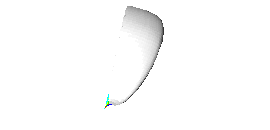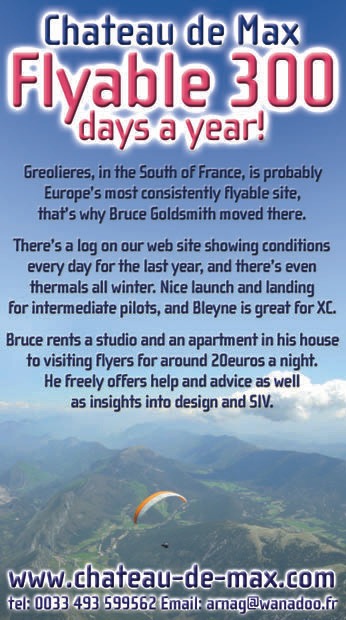How it works
A modern paraglider is so complex that it's not really possible to design one without a sophisticated design program. This is because there are so many design parameters involved, all of which are interrelated in three dimensions. There are also a huge number of components in a paraglider.
The design program usually starts with the designer deciding on his new creation's planform and aerodynamic profile, but of course there are many more parameters than that. As an example, a typical 50 cell intermediate glider will have around 200 lines, and each line needs to be accurate in length to within millimetres. The canopy will have 400 different panels, each one with a unique shape that has to be carefully calculated.
Gliders are of course symmetrical in design, so there are actually only around 200 different individual panels as the two sides are simply mirror images of each other. But some colour schemes are asymmetrical, such as Airea's for instance. All this detailed repetitive number crunching is what computers are so good at, and is why they have become an essential part of designing a paraglider.
But this is just the start. After making the first prototype, the designer and his test pilots then test fly the glider to see if the design concept works. This is the tricky part, because each design has literally hundreds of different parameters, and the designer has to decide which of the parameters he needs to change to improve the design. The prototype is then modified and test-flown again and again with different modifications. Usually several prototypes are needed until the designer achieves his goal.
Design software
Most paraglider design software works using AutoCAD itself and is actually a bolt-on addition to AutoCAD. Others work independently as stand alone software. It's actually possible to design a paraglider just using AutoCAD. Some companies do this, but it can be quite time-consuming.
The first thing to grasp about all these design programs is that they're geometric models. This means that the program models the shape of the paraglider in three-dimensional space, t enabling the designer to create the shape of glider he wants. But the program doesn't calculate what that shape should be. That's down to the skill of the designer. It's all quite similar to the way an architect designs a building. The CAD program helps him create the shape he wants, but doesn't design the building for him. The similarity with engineering goes further than this. The design program doesn't tell you if the glider is going to be a good one or a bad one once it is completed. Just like the architect, his program doesn't tell him if the building will be successful once built.
This is why the test flying of paragliders is such an important part of any R+D program. It's the test flying which tells the designer if he is on the right track or not. There are some flow analysis programs that can help the designer, but there's no substitute for actually flying the glider.
What's available
Many paraglider companies have developed their own software, and there are even some commercially available software packages on sale. Normal retail price for one of these design packages is in the region of 10 000 euros, though this price does change depending on what's included in the package. For instance, some packages also require you to have AutoCAD to run the program on.
Several companies like Nova, Airwave, Advance and Pro-Design have their own exclusive design software. These programs are the property of the paragliding company that has designed them and are closely guarded secrets.
Commercially available packages
Some enterprising computer programmers have written paraglider design programs that can be purchased by any company or individual.
'LT Paraglide' is a new paraglider design program on the market from ex-Freex designer Rasso von Schlichtegroll, but it's not yet used by any paraglider manufacturer. The program is in German, but Rasso is writing an English version that should be released in October 2003.
|
If you're a budding designer you might want to contact Rasso on info@living-things.net.
Michael Nesler is a German paraglider designer and programmer who lives in Bolzano, Italy. His software, 'FlyCad FD' is an application for AutoCAD, written in C++ and AutoLisp, and it can be used to design paragliders, kites, balloons, airships and even inflatable boats. It's used by his own company Independence, as well as Swing, Firebird, Edel, Perche, Airea, Wings of Change and Windtech.
Last year I visited Karel Vrbensky in his top floor apartment in Prague, the capital of the Czech Republic. Karel originally developed his program, 'PG Design', for Mac paragliders. They decided that by selling the software to several manufacturers they could spread the ongoing development costs of the program. Mac now resell PG Design to several clients, including Edel and Gradient.

The future
There's huge scope for future improvements in paraglider software. There is little or no airflow analysis in the existing programs, and as far as I'm aware nobody has yet tried to model collapsed paragliders. My own program takes into account the elasticity of the lines, and Hannes Papesh says that his program also compensates for the elasticity of the cloth.
Such considerations combined with aero-elastic modelling are perhaps the future, and will certainly be streets ahead of what we are currently using. We know where we want to go, we just need a few million euros to pay for the programming and the computers to get there.

|

